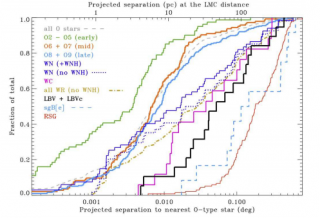Based on their relatively isolated environments, we argue that LBVs must be primarily the product of binary evolution, challenging the traditional single-star view wherein LBVs mark a brief transition between massive O stars and Wolf-Rayet (WR) stars. If the latter were true, then LBVs should be concentrated in young clusters and found alongside main-sequence stars with similarly high inferred initial mass. This is decidedly not the case. Examining locations of  LBVs compared to O stars in our Galaxy and the Magellanic Clouds reveals that LBVs systematically avoid clusters of O stars, and many reside over 100 pc from any O star. In the LMC, LBVs are statistically much more isolated than O-type stars, and (perhaps most surprisingly) even more isolated than most WR stars. This makes it impossible for LBVs to be massive stars in transition to WR stars. Instead, we propose that massive stars and supernova (SN) subtypes are dominated by bifurcated evolutionary paths in interacting binaries, wherein most WR stars and SNeIbc correspond to the mass donors, while LBVs (and their lower-mass analogs like B[e] supergiants, which we show to be even more isolated) are the mass gainers. LBVs are essentially the late evolutionary stage of massive blue stragglers. Through binary mass transfer, rejuvinated mass gainers get enriched, spun up, and sometimes kicked far from their clustered birthsites by their companion's SN. This scenario agrees better with LBVs exploding as SNeIIn and the observed isolation of SNe~IIn and SN impostors. We argue that environmental trends of various SN subtypes are influenced more by binarity and SN kicks, rather than tracing initial mass as is generally assumed. Mergers or Thorne-Zykow objects might also give rise to LBVs, but these scenarios may have a harder time explaining why LBVs avoid clusters.
LBVs compared to O stars in our Galaxy and the Magellanic Clouds reveals that LBVs systematically avoid clusters of O stars, and many reside over 100 pc from any O star. In the LMC, LBVs are statistically much more isolated than O-type stars, and (perhaps most surprisingly) even more isolated than most WR stars. This makes it impossible for LBVs to be massive stars in transition to WR stars. Instead, we propose that massive stars and supernova (SN) subtypes are dominated by bifurcated evolutionary paths in interacting binaries, wherein most WR stars and SNeIbc correspond to the mass donors, while LBVs (and their lower-mass analogs like B[e] supergiants, which we show to be even more isolated) are the mass gainers. LBVs are essentially the late evolutionary stage of massive blue stragglers. Through binary mass transfer, rejuvinated mass gainers get enriched, spun up, and sometimes kicked far from their clustered birthsites by their companion's SN. This scenario agrees better with LBVs exploding as SNeIIn and the observed isolation of SNe~IIn and SN impostors. We argue that environmental trends of various SN subtypes are influenced more by binarity and SN kicks, rather than tracing initial mass as is generally assumed. Mergers or Thorne-Zykow objects might also give rise to LBVs, but these scenarios may have a harder time explaining why LBVs avoid clusters.
Authors: Nathan Smith, Ryan Tombleson

